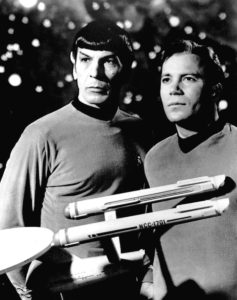 The other day my husband wondered out loud what it would be like to run any ship in the Federation other than the Enterprise.
The other day my husband wondered out loud what it would be like to run any ship in the Federation other than the Enterprise.
Let’s think this through.
Your ship would quietly begin to catalogue two galaxies that had started to run into each other while Captain Kirk discovered yet another earth-like planet that shared the same wildlife, history, topography, language, and culture as our planet.
When Captain Archer’s crew suddenly became extremely ill from a mysterious disease that humans have no immunity to, you’d be trying to figure out how to spread out what was often fairly limited shore leave among your crew members in the most equitable way possible.
The most exciting part of your day would be figuring out what kind of protein the cook was serving that day. While the food was always excellent, sometimes you couldn’t tell if you were eating chicken, tofu, or something else entirely.
Their stories would make you shake your head when you met crew members from this ship at Starfleet Academy reunions or other celebrations. Sometimes you wondered if they were exaggerating when they talked about the things they’d seen out there. The known universe is a mostly empty place. You’ve known captains who spent years between one anomaly and the next one.
None of the other ships in the entire fleet run into gods, time loops, or the Borg even 5% as much as the Enterprise crew somehow manages to. The whole thing is incredibly bizarre. What is it about that specific ship that draws such strange circumstances to them?
With that being said, people who transferred from the Enterprise to other places sometimes talk about missing the  adrenaline rush of a crisis. Mapping new parts of space is important, but it’s quite rare to run into any hostile, or even sentient, species. Mostly you’d find the occasion planet that had developed simple forms of life. The exobiologists always found them exciting, but they generally looked quite similar to Earth amoebas or slugs to anyone else who happened to take a look at the petri dish or aquarium.
adrenaline rush of a crisis. Mapping new parts of space is important, but it’s quite rare to run into any hostile, or even sentient, species. Mostly you’d find the occasion planet that had developed simple forms of life. The exobiologists always found them exciting, but they generally looked quite similar to Earth amoebas or slugs to anyone else who happened to take a look at the petri dish or aquarium.
Of course, no other ship had such high death rates, either. It was both a blessing and a curse to be assigned to that crew. A lot of people wrote out their wills and settled their affairs beforehand in case they were part of the unlucky percentage who didn’t survive their stay. Their excitement at being assigned to such a prestigious ship was always dulled by the threat that this transfer could also be the thing that lead to their death.
Yes, between 80 and 95% of the people who served on the original Enterprise survived over the longterm depending which role they held there. In a time when people almost always lived to a ripe, old age, though, these statistics were alarming. You would probably get through a few years on the Enterprise without any permanent injuries before being transferred elsewhere in the fleet, but the chances of losing at least one of the friends you made while working there ranged from possible to fairly high.
Is it possible to feel jealously and relief at the same time?
You ask yourself these questions every time a new position becomes available on the Enterprise and your transfer request for it is turned down.
